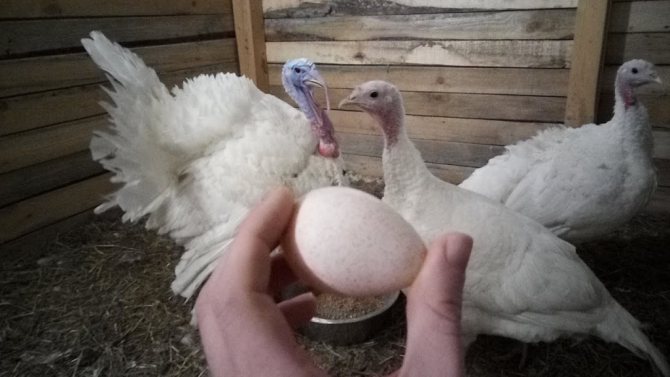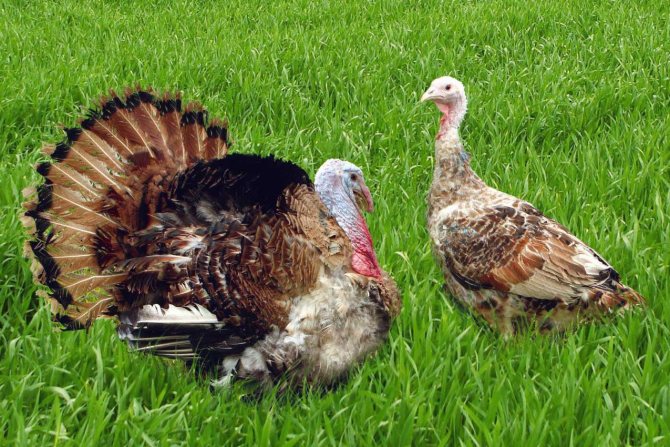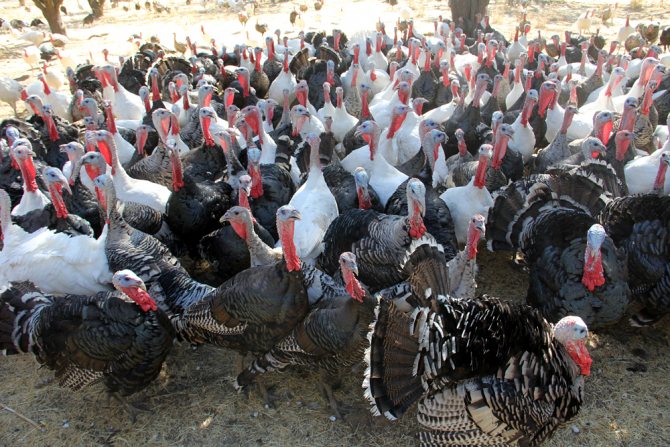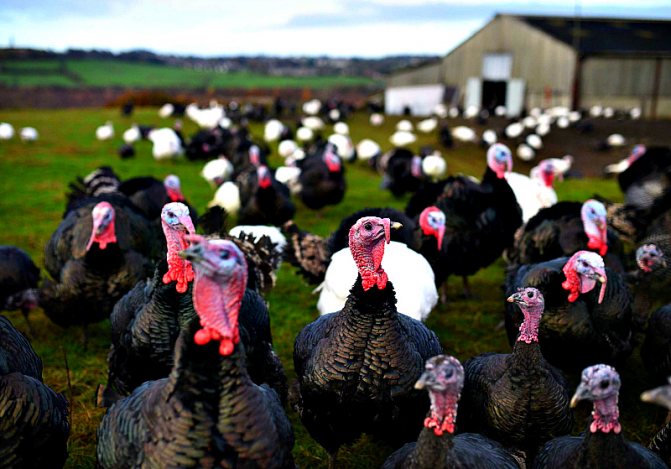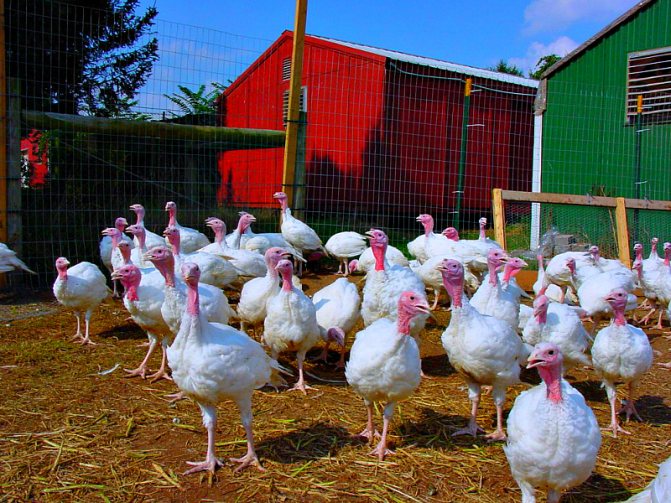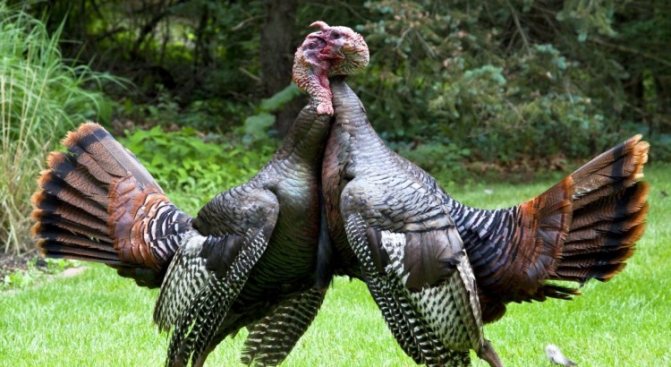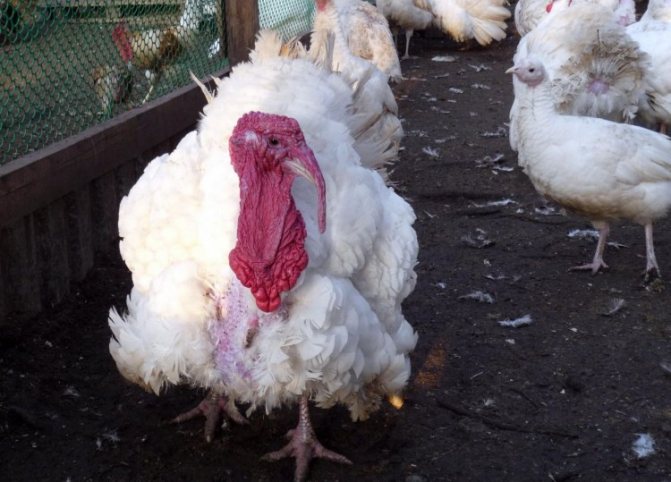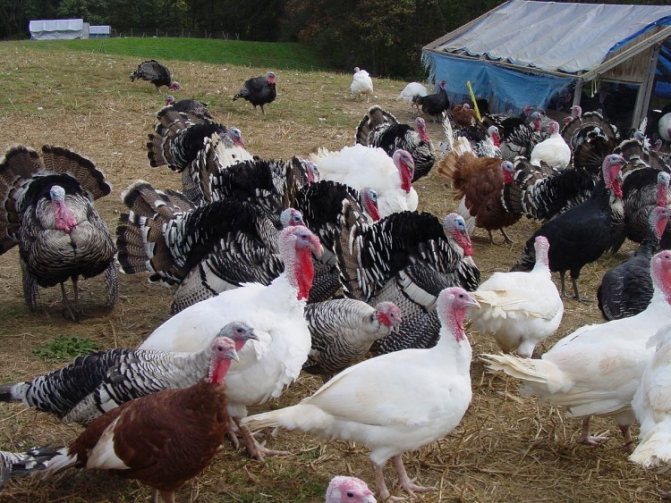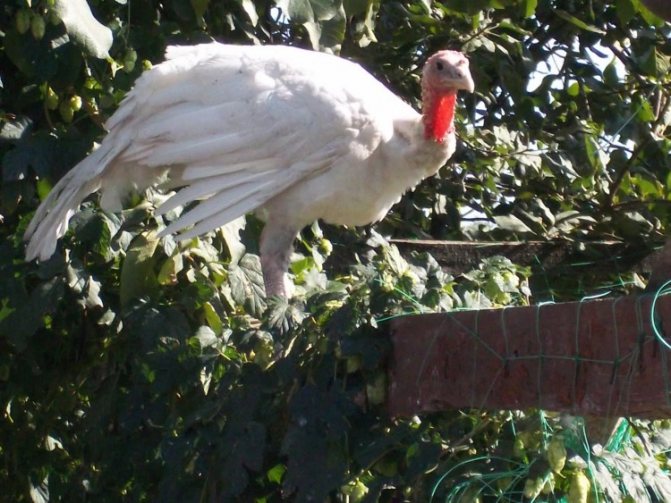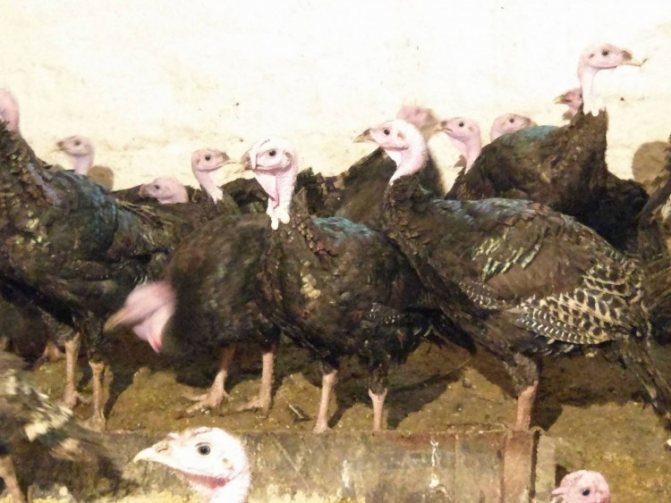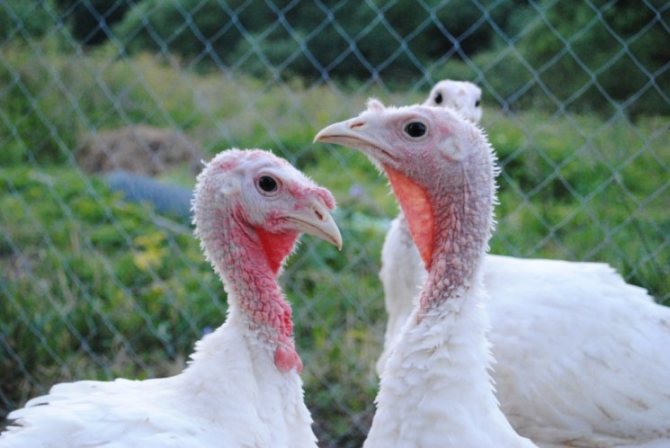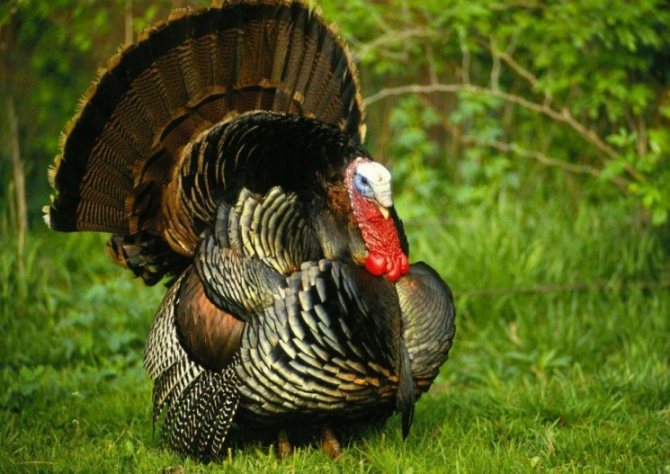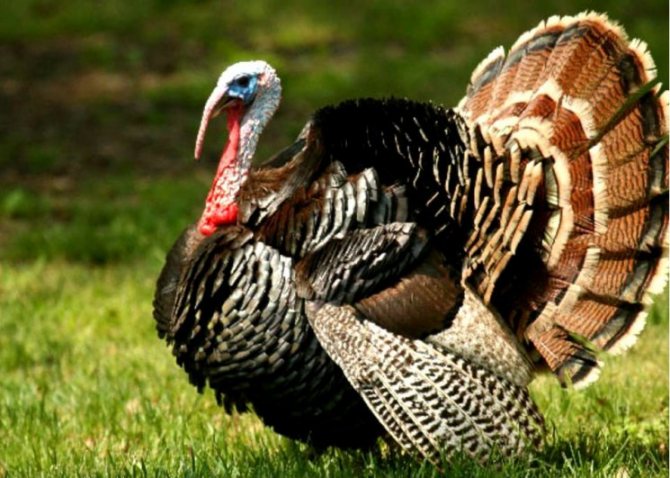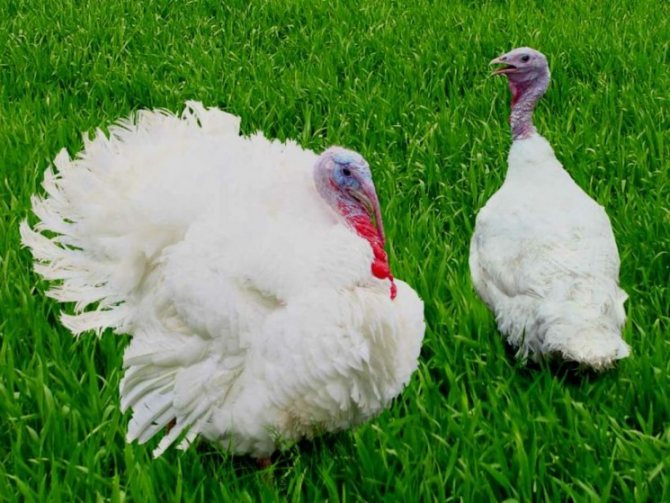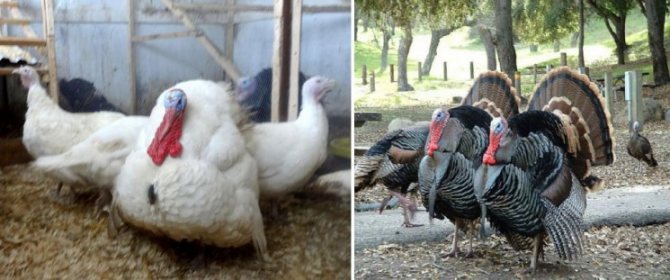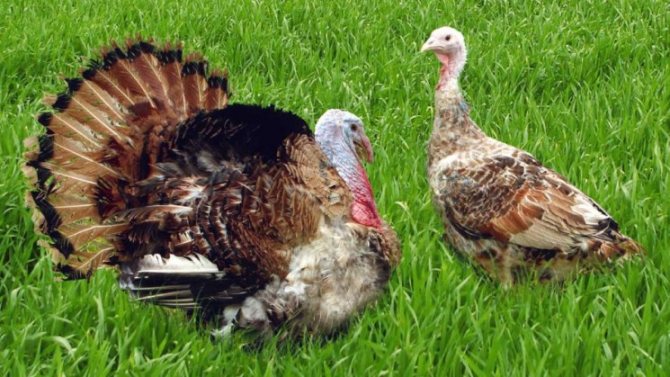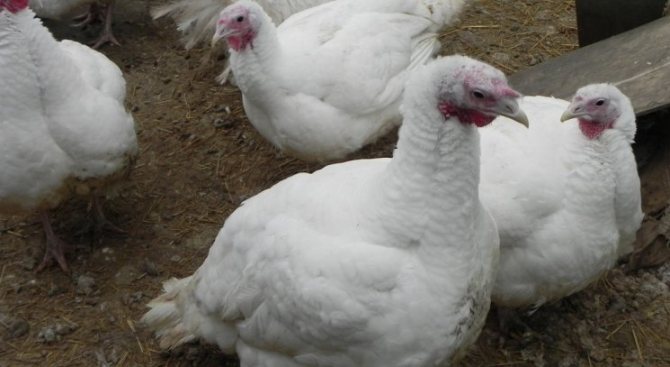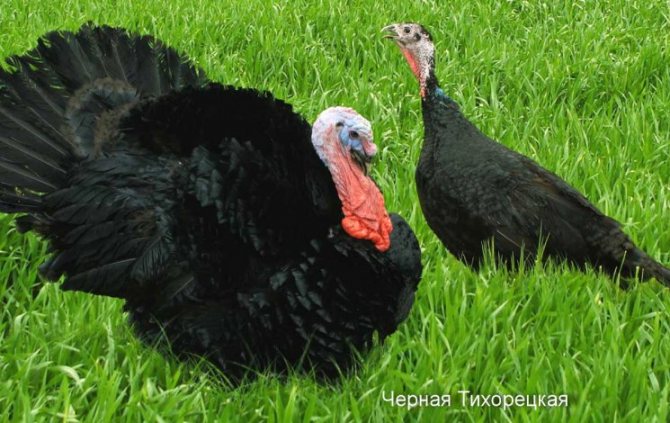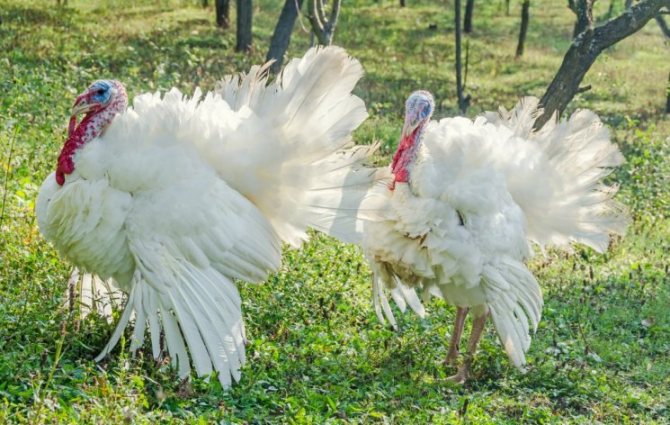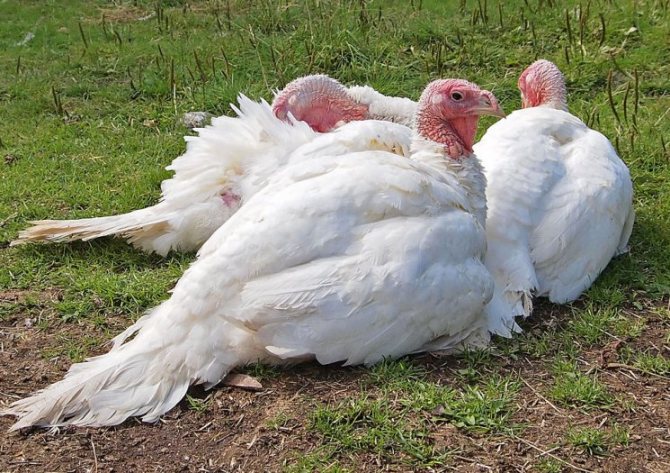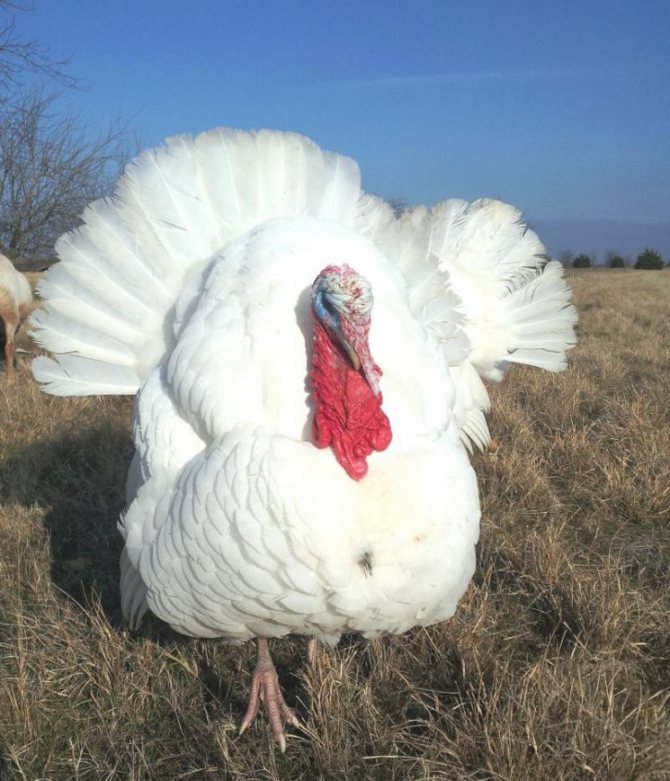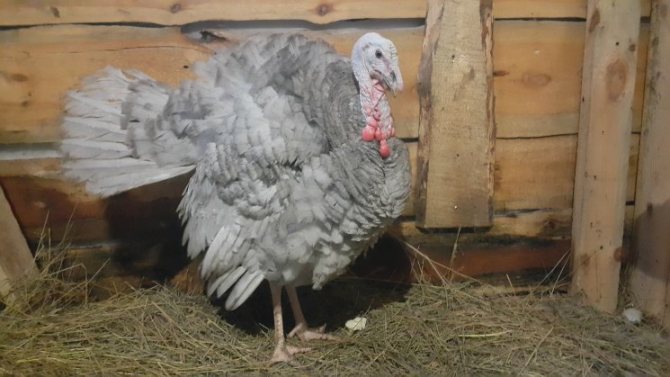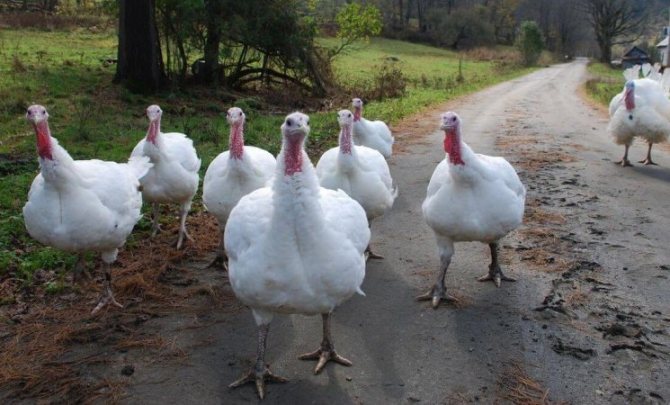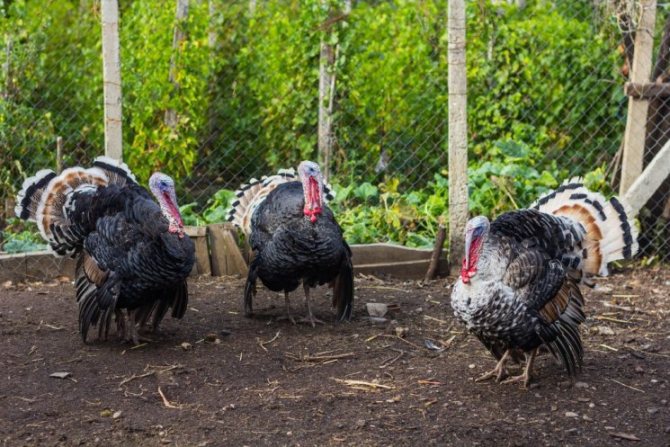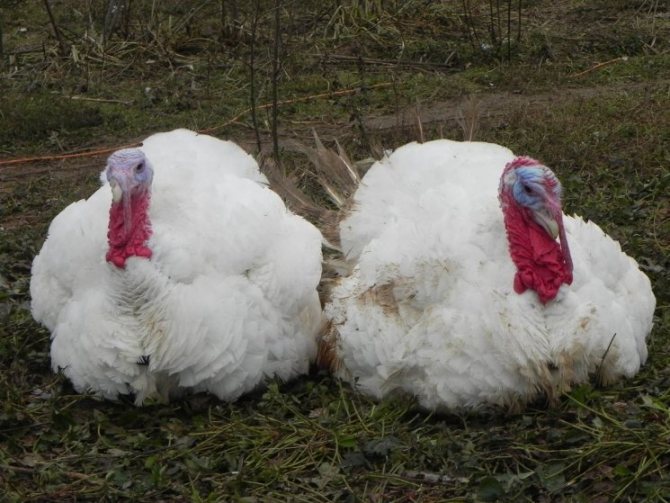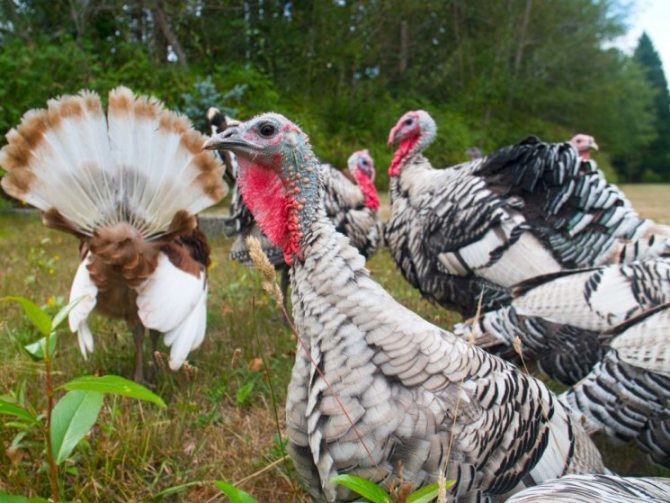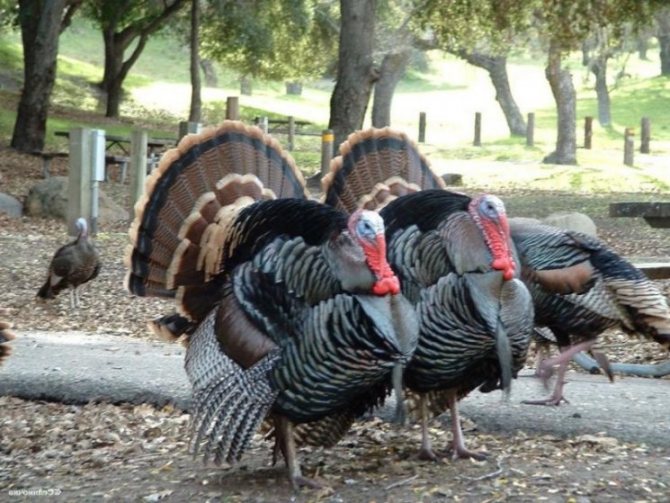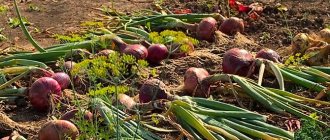Poultry »Turkeys
0
2292
Article rating
Turkeys are colorful, dignified birds that were tamed by man many centuries ago and they moved to the European continent from the American one. The ancestor of these birds was distinguished by considerable activity and was completely unlike modern stately and self-confident large birds. Under the influence of the selection selection of the Turkey, many promising breeds were bred, which differ from each other only in the mass and color of the feathers. Growing turkeys is now gaining popularity around the world. To grow domestic turkeys, you need to know all the rules for the care and maintenance of birds.

Proper cultivation of turkeys at home
With the proper approach, even a few birds can generate a small income. Many farmers do industrial business with turkeys, market meat, eggs, or raise young animals for sale.
At home, for beginners, it is possible to grow turkeys from scratch, the main thing is to approach this issue responsibly and calculate the profitability. Growing several crosses on a farm can be done by renting a plot and making several poultry houses. Before raising turkeys, you should study the full description of bird breeds, as well as watch photos and videos about all aspects of nutrition and maintenance. The price of a turkey starts from $ 5 for individuals, if translated into rubles, it will turn out to be about 300 rubles. How much a turkey costs, you need to look specifically in your region and take into account other features of the young.
Features of breeding turkeys at home for beginners
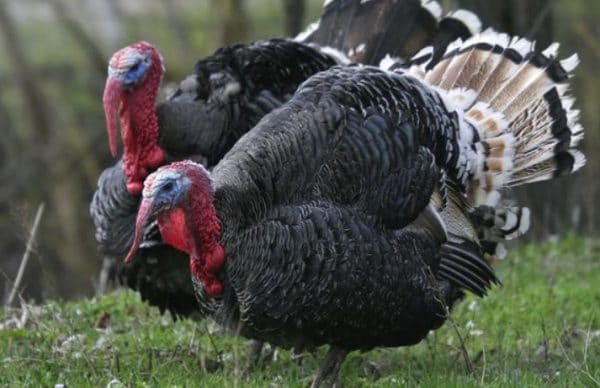

Turkeys are a type of poultry that grows quickly and gains weight with proper care
Growing at home allows you not only to provide your family with delicious dietary meat, but also to earn extra money. Initially, this will require additional financial costs, but all investments will be returned in full within one season.
The weight of an adult male is 23-24 kg, and that of a female is 10 kg. But broiler breeds have already been bred, in which the weight reaches 35 kg.
For breeding, you must initially purchase an adult male and several females of a suitable breed. It will be easier for a novice poultry farmer to cope with them, and at the same time gain experience. The breeding herd is formed at the rate of 10 females per 1 male.
Successful egg-laying requires at least 14 hours of daylight and a temperature of 10-15 degrees.
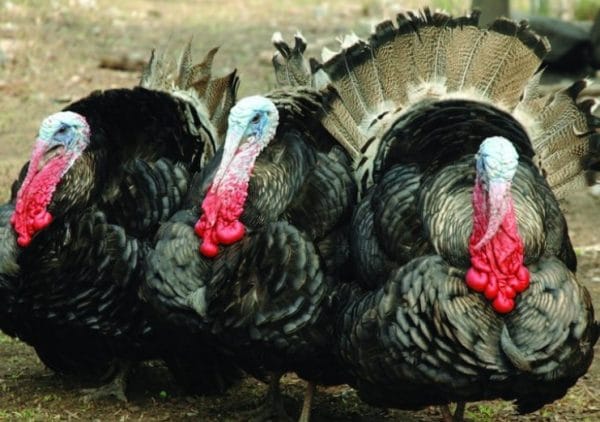

For successful egg-laying, a day length of at least 14 hours is required, and a temperature of 10-15 degrees
Turkeys lay eggs 3 times a year: in March, June, August. When the female has applied 17-20 pieces, egg-laying stops. To extend it, you need to collect eggs daily. They are used for laying in an incubator, and the rest are placed under the turkey.
Eggs for offspring should be collected in the spring, so that the chicks can grow up and form by winter. All of them must be intact, without cracks and obvious deformations. For 1 female, 15-17 eggs are enough.
Using incubators and brooders
Turkeys are caring mothers. During the incubation period, they are so absorbed in caring for the chicks that they forget about food and water. They should be regularly removed from the nest to meet their natural needs.
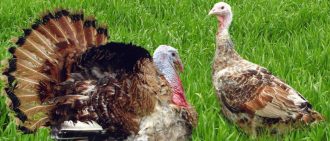

Be sure to read:
Turkey and turkey: are birds different, what they look like, how to determine gender
Chicks hatch on the 28th day. They need to be immediately planted with a brood hen, which will take care of them for 6-8 weeks.
For quick breeding, use an incubator. The collection of eggs is carried out within 7 days. During storage, the temperature should be +12 degrees.
Then it is laid in the incubator. For successful hatching, it is important to turn the eggs 12 times daily for 22 days, as well as airing the 1st and 2nd week for 5-7 minutes, and the 3rd and 4th week - 15 minutes each.
Temperature range for successful hatching:
| Period | Temperature | Humidity |
| 1-7th day | +38 degrees | 70% |
| 8-25th day | + 37.6 ... + 37.8 degrees | 60% |
| 26-28th day (biting) | + 37.0 ... + 37.5 degrees | 90% |
In the last days of incubation, it is important to increase the air humidity to the required level. For this, it is recommended to additionally place containers with water.
BIG-6
This breed is a hybrid bred by British scientists for selection. In appearance, individuals are similar to white broad-breasted turkeys. They are the same large ones with white plumage and a bright head, but they have features inherent only to them:
- the chest is more powerful and decorated with a voluminous black spot;
- strongly developed limbs;
- increased early maturity.
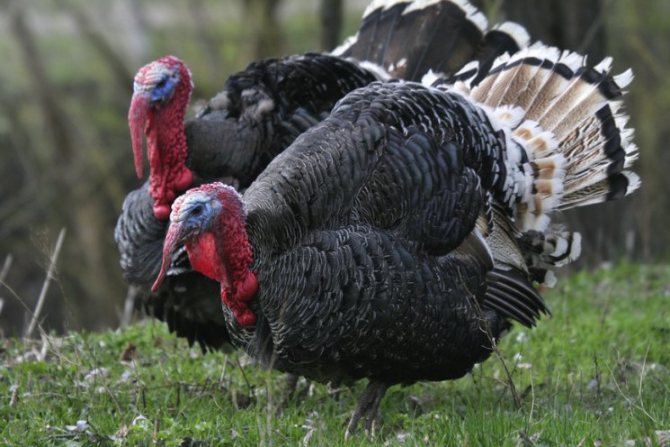

Fattening of turkeys takes a month and a half. After this period, the chicks gain weight up to five kilograms. Further growth continues with the usual diet and by five months the individual already weighs about 11 kg. One kilogram of growth needs two kilograms of feed.
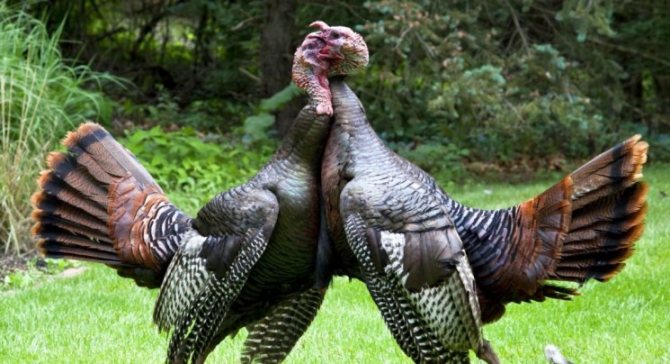

Mature heavy individuals reach weight: males - 25 kg; females - 15 kg.
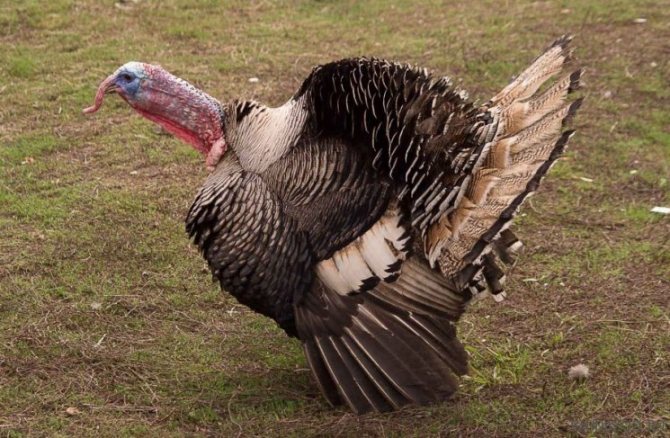

Layers begin to lay at the age of seven months. In a year, a turkey brings one hundred eggs 80 g each.
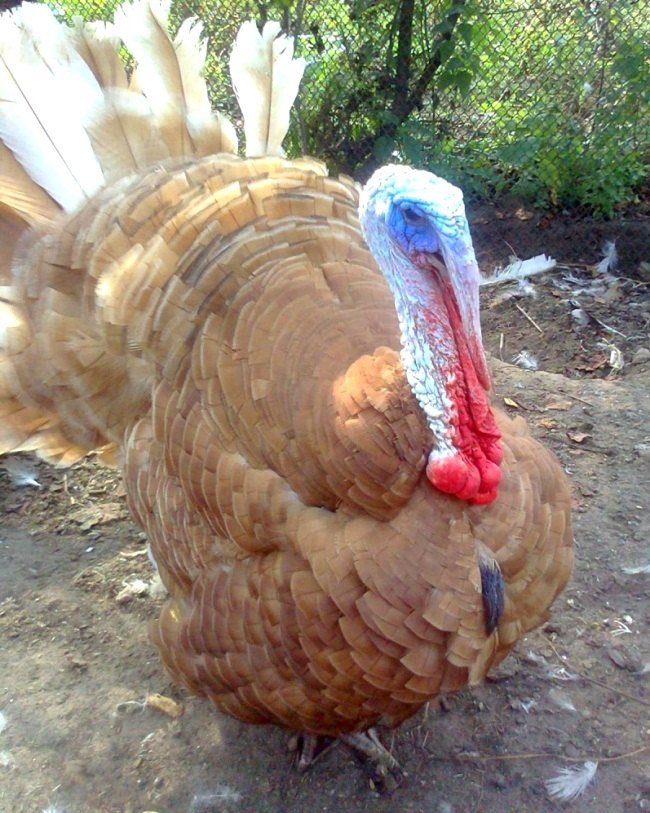

Features of turkey care
When growing, you should adhere to certain rules of care. This applies to the conditions of detention, the diet of feeding and walking in the surrounding area.
Requirements for the premises
You can keep turkeys in a regular barn. Its size depends on the number of livestock. For 1 adult, there should be 1 square meter. m, and for broiler breeds - 1.5 sq. m.
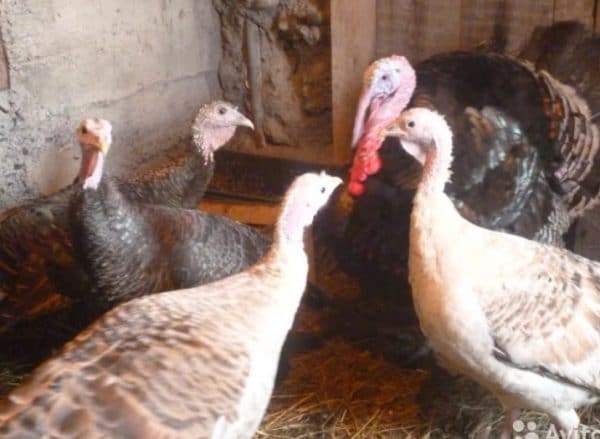

You can keep turkeys in a regular barn
There should be windows in the room, it is better to place them at a height of 1 m. They are a source of light and also serve as additional ventilation. For ventilation, you must also equip hoods under the ceiling. The optimal indicator of humidity is 60-70%, temperature is not lower than + 5 ... + 8 degrees.
The poultry house should be provided with artificial lighting (60 W per 1 sq. M), since the duration of daylight hours should be 12-14 hours. The walls should be plastered and whitewashed with slaked lime. Lay a layer of straw 10-15 cm high on the floor, changing it every 10 days.
For food and water, install special containers that the birds cannot turn over. Feeders should be different for wet and dry food.
Important! Successful turkey farming requires hygiene, and all equipment and premises should be washed regularly as they become dirty.
The house should be equipped with nests. They are installed along the wall in several tiers. Their size is 60-70 cm on each side.
For manufacturing, you will need to knock down wooden boxes, and pour a thick layer of straw on the bottom. It is also worth setting up perches against the back wall for easy positioning of the birds in the house. When grown separately, the room is equipped with cages.
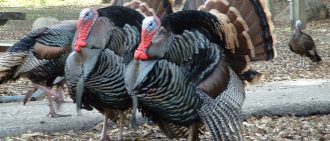

Be sure to read:
How to feed turkeys to gain weight quickly at home?
Feeding and feeding turkeys
Feeding chicks and adults varies dramatically. When chicks are born, they should be fed with chopped boiled eggs.
On the 3rd day, the diet is replenished with millet, groats and low-fat cottage cheese.At the age of 7 days, chicks can be fed green onions, boiled carrots and potatoes, as well as using chopped cereals.
After 14 days, the young are added to the mash with a green mass of dandelion, scalded nettle, lettuce, parsley. During this period, fishmeal is added to the feed. One month old turkey poults can be fed with sprouted grains.
Two-month-old chicks are fed with whole grains, compound feed, cereals, herbs, boiled vegetables... Separately, in a container, it is worth pouring a mixture of meat and bone and fish meal, chalk, shells and fine gravel. They are a source of minerals and improve digestion.
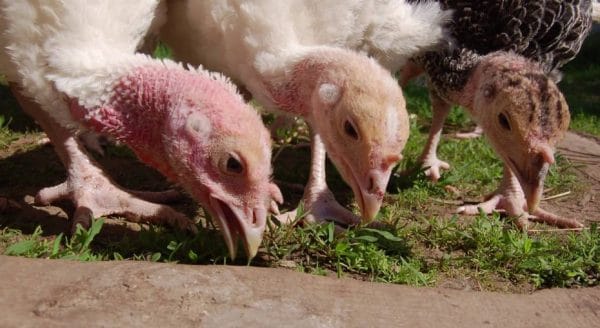

Feeding chicks and adults varies dramatically.
Feeding mode per day:
- up to 1 month - 5 times;
- from 1 to 2 months - 4 times;
- over 2 months - 3 times.
When fattening, it is recommended to use feed with increased nutritional value, and when raising breeding birds, feeding should be moderate with an increased content of green mass.
Feeding for meat
Among all poultry, it is turkeys that are characterized by rapid weight gain, but their nutrition should be properly composed, rich in useful components and proteins.
A balanced diet for an adult is formed from many components.
- Cereals and legumes, oats, wheat, buckwheat. They contain a huge amount of vitamins and minerals, which contributes to harmonious development.
- Oilcake and meal, saturated with amino acids.
- Greens and root vegetables, as a source of carbohydrates.
- Green food to fill the body with fiber.
- Hay, straw and young tree twigs as they are high in fiber.
- Compound feed for fast feeding.
- Bone meal and salt 2 g daily to maintain optimal mineral balance.
- Cottage cheese and dairy products, for calcium saturation and harmonious growth.
- Waste from fish to support the immune system.
- Auxiliary ingredients: walnuts, vegetable oil, lard.
In order for the meat to be juicy and tender, you should make sure that a sufficient amount of vegetables and herbs gets into the food. Layers and fertilizers need enhanced nutrition, therefore, to feed them, the amount of compound feed, root crops, cottage cheese and bone meal is increased.
Feeding is carried out in accordance with certain conditions. Subtleties you need to know:
- Food is served three times a day at regular intervals.
- Throughout the day, they are fed with green food and nutritional supplements. For this, wet mixtures are prepared based on soaked oats, and dry cereals are issued in the evening.
- Combined feed can be introduced in separate feeders or mixed with other feeds;
- When walking, it is recommended to provide an opportunity to peck the grass on your own.
Experienced farmers, a month before slaughter, limit the physical activity of turkeys to maximize weight gain.
Growing turkey poults at home for beginners
To keep chicks, you should initially use a spacious cardboard box. A layer of straw should be laid on its bottom.
Place a heating lamp on top at a distance of 50-60 cm from the chicks. The first week after the hatching of the chicks, the temperature of the content should be + 30 ... + 32 degrees, after 5-7 days it should be lowered to +28 degrees, and starting from 14 days - to +24 degrees.
Attention! Turkey poults slowly adapt to the new environment, it is impossible to mix several broods at once.
Walking chicks is allowed from the age of two months at a temperature not lower than + 15 ... + 18 degrees. Raising young stock up to 1 month is the most laborious process.
Which breeds are best suited
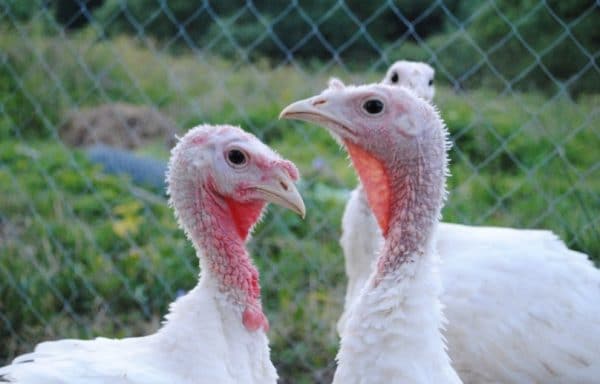

For successful cultivation, it is important not only to compose a diet and equip a room, but also to choose the right breed.
For successful cultivation, it is important not only to compose a diet and equip a room, but also to choose the right breed. The main advantage of this poultry is its high meat performance.
The most demanded breeds:
| Name | Adult weight (kg) | Egg production (pcs.) | Output final product (%) |
| Moscow greyhound | Male - 12, female - 6-7 | 90 | 75-80 |
| Hybrid | Male - 20-22, female - 10-12 | 50 | 80-85 |
| Victoria | Male - 20-25, female - 10-11 | 80 | 75 |
| Black Tikhoretskaya | Male -10, female - 5-6 | 80-90 | 60 |
| White broad-breasted | Male - 17, female - 8-10 | 80 | 75-80 |
Meat
The Aztecs noticed the meaty characteristics of wild birds. A male two to three years old reached a weight of up to forty kilograms. Thanks to the intervention of scientists, individuals of modern species have noticeably accelerated growth. They gain seventy percent of the mass by four months.
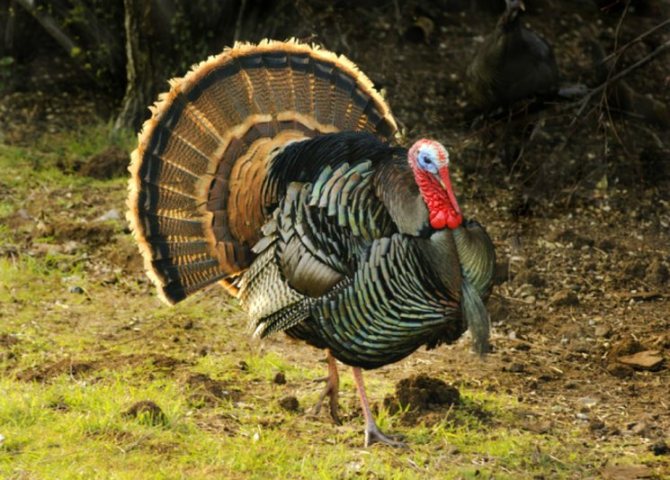

Turkey meat breeds include common and productive species such as:
- Moscow bronze;
- white broad-breasted;
- Hybrid Converter;
- BYuT-8;
- BIG-6.
Home content
This type of bird does not tolerate crowding, it is necessary to organize walking for it. For this, the area adjacent to the house should be fenced off so that the birds feel comfortable.
Install sufficient feeders and drinkers there.
Winter maintenance
High humidity, drafts and cold negatively affect the health of the livestock. In winter, it is recommended to additionally insulate the walls and floor so that the room temperature does not drop below +5 degrees. Daylight hours should be 12-14 hours, additional lighting should be turned on in the evening.
To prevent the birds from freezing their paws during walking in the cold period, a layer of straw should be laid on the ground. For the winter, leave only the breeding herd, which is necessary for further breeding.
Keeping birds in summer
In the warm season, a special shelter is needed where birds can hide from the scorching sun rays and possible precipitation.
The area for walking should be planted with clover, alfalfa and other herbs to allow the turkeys to get enough vitamins.
Universal
It is difficult to say which turkey breeds are the best, someone prefers more meat, someone eggs, there is another option - universal breeds.
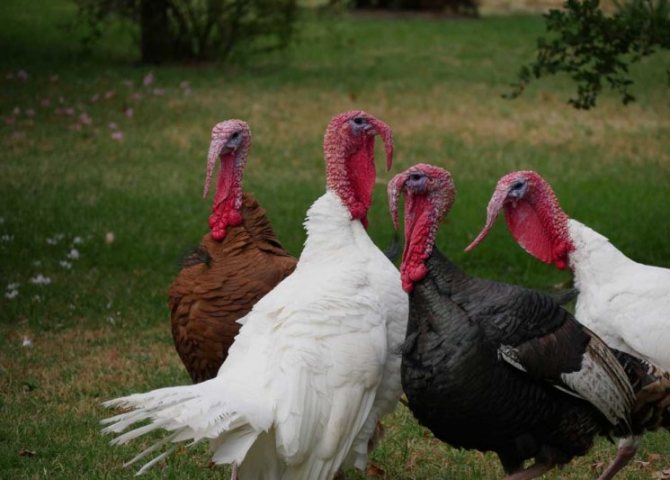

For keeping birds for double productivity, the best breeds will be:
- North Caucasian bronze;
- Uzbek fawn and white species.


Before you start turkeys, you need to decide for what purpose they will be intended. Based on this, already choose the breed.


You can clearly see the external distinctive features of birds on a photo of turkey breeds in any sources.
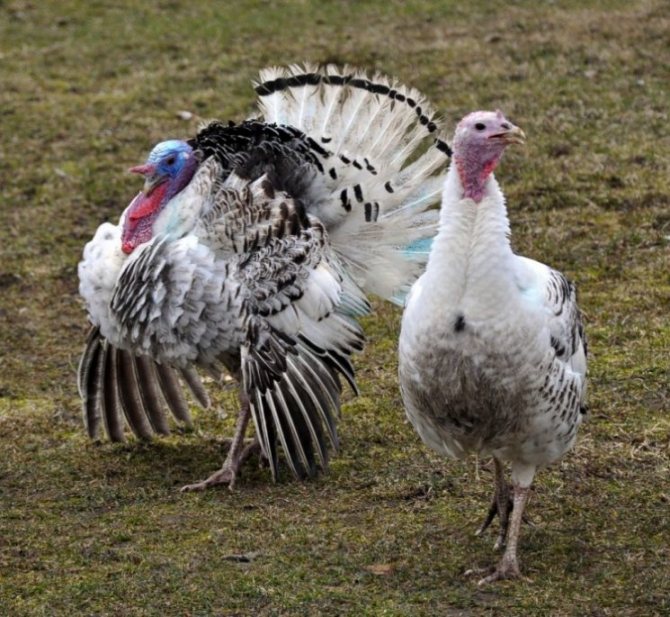

The main diseases of domestic turkeys and turkeys
Turkeys are susceptible to various diseases.
Common pathologies:
- Histomoniasis. It is caused by the simplest - histomonads. Sick individuals and parasitic carriers are the source of infection.
- Respiratory mycoplasmosis. An infectious disease caused by an unbalanced diet and high humidity.
- Tuberculosis. The infection is transmitted through dirty water, contaminated equipment, bedding.
- Smallpox. It is transmitted by infected insects, as well as through food and water.
- Worms. Infection occurs when the conditions of detention are not observed, as well as in the absence of preventive measures.
Cross butt 8
This subspecies is also the result of British United Turkeys. Belonging to medium and heavy subdivisions, in five months chickens gain 25-27 kg (for males) and about 10-11 kg (for turkeys).
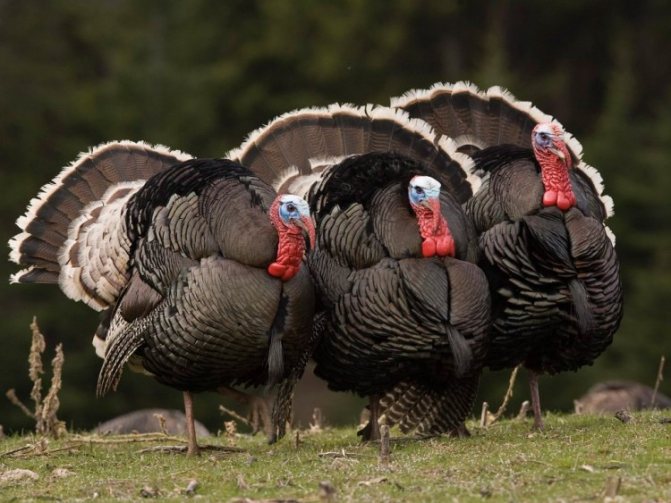

Among other broilers "Cross Butte 8" stands out for its purity of color without "marks", red growths around the beak, neat outline of the body.
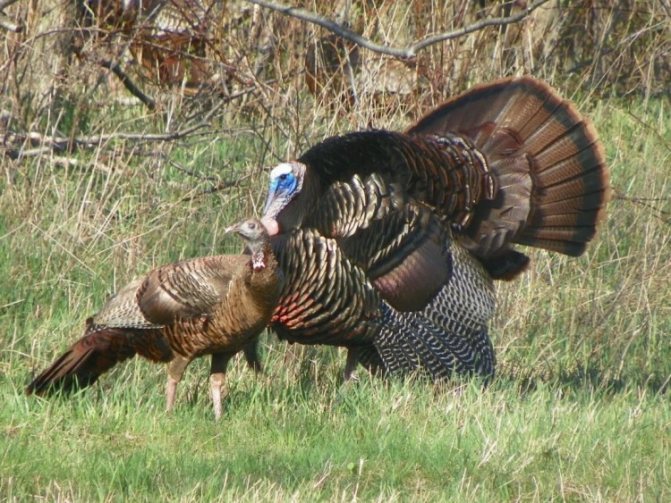

This subtype has not received wide distribution in Russia.


Pros and cons of home breeding
Breeding and raising turkeys has several advantages.
These include:
- high taste qualities of meat and eggs;
- high yield of final products;
- lower feed costs in comparison with other types of poultry;
- the ability to realize down and feather.
A significant disadvantage is the high mortality rate of young animals. This quality significantly reduces the interest of poultry farmers in turkeys.
To avoid this, novice farmers should buy already grown chicks. This will allow you to gain experience for further independent breeding.
Egg
The turkey lays eggs larger than hens, with cream-colored shells and dark brown specks.
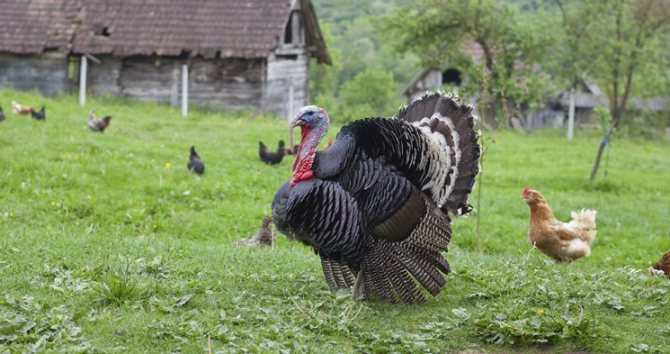

Breeding birds with increased productivity and rapid puberty will help to get enough eggs. The best oviparous species are:
- white Moscow;
- bronze;
- virgin;
- hybrid BIG-9.
Bronze broad-breasted
It was obtained in America as a breeding cross between black English and wild "branches". It is named so due to the powerful development of the thoracic region. However, in general, the final indicators are small - 15-16 kg and 10 kg for males and females.
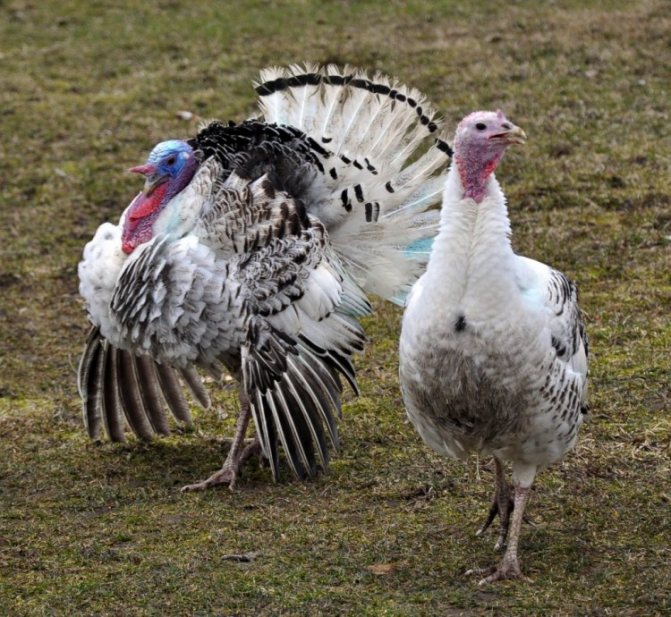

"Bronze broad-breasted" is distinguished by the original color of the plumage - dark, shimmering green. The tail feathers are striped, brown-beige, bordered with dark. Females have light spots on the breast.


This line refers to the "egg" direction. The total number of eggs laid by turkeys can be 120 pieces. Their fertility is very high, and the hens themselves have a strong maternal instinct - they hatch their own and others' offspring equally successfully.
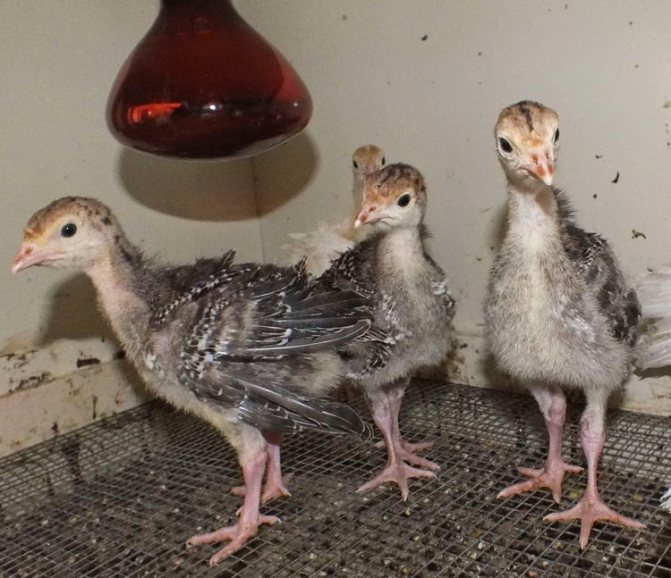

Treatment of turkey poults - symptoms, prevention, main diseases and features of care and raising turkey poults

Keeping turkeys: care, breeding, breeds, conditions and profitability of a turkey farm (115 photos)
- Feeding turkey poults: norms and time of feeding, optimal diet and mixture composition depending on age (110 photos)


Hybrid converter
They are of industrial importance, widespread both in Russia and abroad. They pass the full life cycle at poultry farms supplying raw materials to meat processing complexes. The Canadian breeding centers managed to bring them out.


The term for them to gain the bulk (on average 22 kg in males and 12 kg in females) is five months. They are included in the meat poultry industry, since the total volume of carcasses accounts for 80-85% of muscle mass.
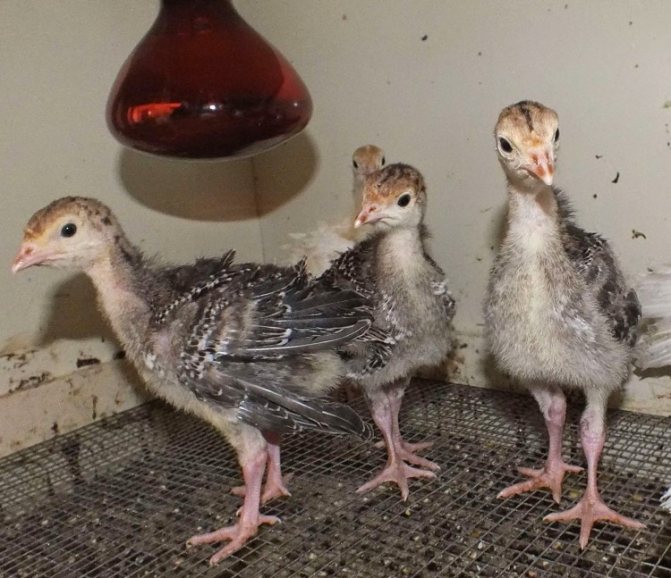

Bronze North Caucasian
The merit in the development of this "line" belongs to the breeders of the Stavropol Territory. For a long time, the main area for breeding such turkeys was the Central Asian republics. They are still in demand because of the rapid growth and weight gain, survival rate and undemanding diet.


After the first month, the grown chickens weigh 4 kg, by the age of slaughter they grow to 12-15 kg and 8-9 kg (for males and females). Carcasses are rich in white meat (25% of these muscles are in the chest).


The appearance of this species is specific - with an elongated, long-legged, with a massive chest, trunk. The appearance of "roosters" is very effective, thanks to the combination of black and brown feathers with a golden-bronze sheen and a fan-shaped tail. Feathers of "chickens" are less catchy, speckled.


Good adaptation of young stock to pasture cultivation is noted. Egg production is not very high and amounts to about 40-50 clutches for the entire period. Juveniles are not intended for slaughter, since they are not marketable due to their purple skin tone.


Cross station wagon
These broilers, optimally adapted for keeping in the private sector, were bred by breeders of the Russian Caucasus. Young animals and adults are characterized by unpretentiousness and low feed consumption.
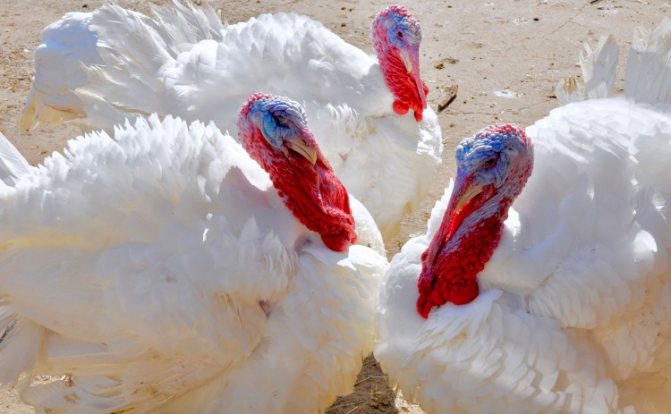

Laying hens are characterized by the ability to lay about 60-70 eggs per year.Viable chicks hatch from almost all of them.


Cross-wagon - medium-weight broilers of the egg direction. By the end of the cycle, males and females reach 17 kg and 11 kg, respectively, for each sex.
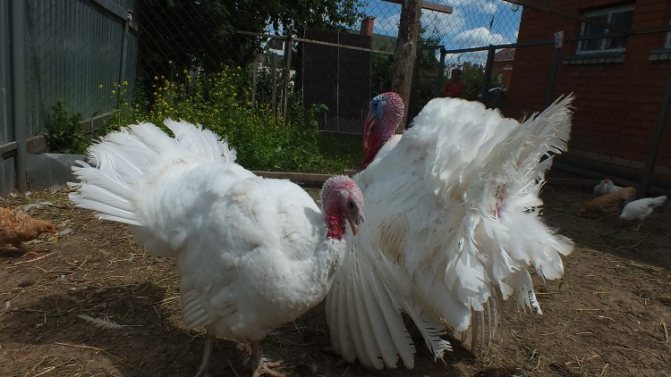

- Growing turkeys - care, maintenance, feeding and profitability of turkey farms (130 photos)
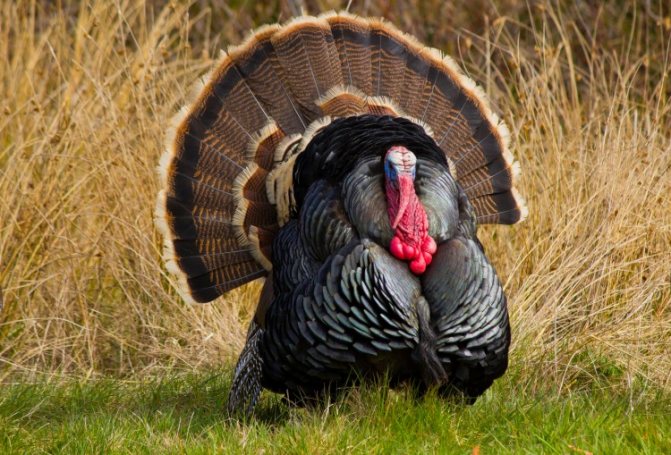

Treatment of turkeys - signs and diagnosis of the most common diseases of young and adult turkeys (95 photos)
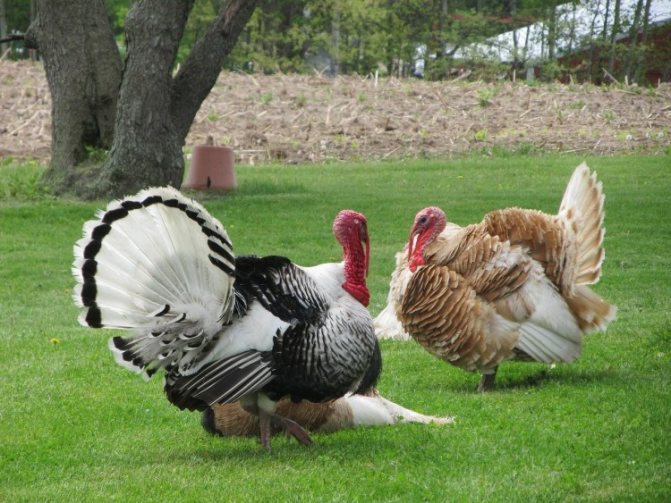

Turkey breeds - the most popular and best breeds for breeding in the household (115 photos)

